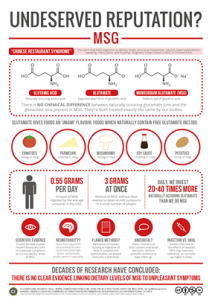MSG, short for monosodium glutamate, has long been demonized. It’s known most commonly as the ingredient responsible for the umami flavor in Chinese food. Does it live up to it’s bad reputation or is just a big misunderstanding? Is it responsible for all of the symptoms associated with “Chinese restaurant syndrome,” or is that just another one of the MSG myths that persist?
Most importantly, what does the science show?
First off, what exactly is MSG? Monosodium glutamate (MSG) is the sodium salt of the common amino acid, glutamic acid, which is naturally present in our bodies and is in many foods and food additives. MSG was first extracted from seaweed broth in Japan in 1908 by a Japanese professor named Kikunae Ikeda. He determined that glutamate provided a savory taste to the soup. Professor Ikeda then filed a patent to produce MSG, and commercial production started the following year. MSG was commonly used in Japanese and Chinese cuisine by the mid-20th century and had spread to numerous other countries, including the U.S. Today, instead of extracting and crystallizing MSG from seaweed broth, it is produced by the fermentation of starch, sugar beets, sugar cane, or molasses.
This same savory, rich, “umami” flavor that MSG contributes can be found in foods such as tomatoes, parmesan cheese, and mushrooms, which contain naturally occurring glutamate, the deprotonated form of glutamic acid.
The glutamate in MSG is chemically indistinguishable from glutamate present in food proteins, and our bodies metabolize both sources in the same way. Additionally, an average adult consumes approximately 13 grams of glutamate each day from the protein in food, while intake of added MSG is estimated at around 0.55 grams per day. Daily, we ingest 20 to 40 times more naturally occurring glutamate than we do MSG.

So, where did the bad reputation come from, and why does it specifically seem to be attributed to Chinese food?
This is where the story gets quite interesting. In 1968, the New England Journal of Medicine published a letter describing “Chinese restaurant syndrome,” naming symptoms that included numbness at the back of the neck and a feeling of pressure in the face and upper chest muscles after eating in Chinese restaurants. The author of the letter, Dr. Robert Ho Man Kwok, didn’t identify any particular component of his meal as causing this effect, but MSG was ultimately blamed. This was purely based off of one single anecdote, but it was taken a lot more seriously since it had been published in a reputable medical journal. You can learn more about the bizarre story behind this letter in this episode of This American Life podcast.
Since then, critics in the United States have claimed that MSG causes everything from cancer to obesity.
So, are these claims actually based on science, or is it all pseudoscience? Glutamate is a naturally occurring amino acid that our bodies produce to survive. It serves as a neurotransmitter in the brain in addition to its general role in protein and energy metabolism. Concerns over MSG arose in the late 1960s after Dr. John Olney of Washington University hypothesized that high doses of MSG may adversely affect brain function. He set out to study this by injecting and force feeding rodents extremely high doses of MSG.
In one study, Olney subcutaneously injected neonatal mice with single dosages of MSG ranging from 0.5 mg/g to 4 mg/g of body weight, inducing brain lesions and other physiological effects in the rodents. To put this into perspective, in order to match the highest dosage used in Olney’s tests, a 70 kg (154-pound) human would have to consume 280g of MSG all at once. This is over 500 times the amount that the average adult consumes and still almost 100 times more than the amount consumed even in places with the highest per capita consumption.
Furthermore, methods of injection and force-feeding obviously do not accurately represent the way humans consume MSG, and the results could not be duplicated when large amounts were administered in the diet. Studies evaluating the normal dietary ingestion of MSG in food, including amounts over 40 g/kg body weight, which is 5,000 times higher than normal amounts ingested, found no harmful effects on the brain. The body of scientific evidence on MSG has shown that as consumed in food, it does not impair brain function or pose risk to public health. Scientific evaluations have shown a lack of MSG mutagenicity, teratogenicity or carcinogenicity as well.

“Chinese restaurant syndrome,” and other ailments claimed to be caused by MSG are not backed by the decades of research. After anecdotal reports of MSG inducing “Chinese restaurant syndrome,” a study that examined 17 males and seven females, between 18 and 34 years old in a double-blind, crossover challenge (the “gold standard” for testing potential adverse reactions to a substance) found no difference in subjective symptoms observed between the MSG group and the control group. The study led to the conclusion that “Chinese Restaurant Syndrome” is an anecdote applied to a variety of postprandial illnesses; rigorous and realistic scientific evidence linking the syndrome to MSG could not be found.
Decades of research have also failed to demonstrate that MSG causes allergic reactions. Anecdotal reports may suggest that a small percentage of the population may be sensitive to MSG, with individuals reporting symptoms resembling some of those experienced with a food allergy, but no scientific research has been able to reliably show that consuming MSG causes these symptoms.
MSG is one of the most intensely studied food ingredients in the food supply and has been found to be so safe that The Joint Expert Committee on Food Additives of the United Nations Food and Agricultural Organization and World Health Organization placed it in the safest category for food additives.
There really is no shortage of research on MSG, and despite the myriad of symptoms being attributed to it, the decades of research just doesn’t support these claims. If you think you may have an adverse reaction to MSG, then you can choose to avoid it. It is required to be listed on the ingredient declaration of any food to which it is added. Also, keep in mind that naturally occurring glutamates are present in many different foods: from tomatoes to soy and yeast extracts. So, if your symptoms specifically only show up after consuming Chinese food, recognize that you could be reacting to some other substance in the food, rather than the MSG itself.
There really is no shortage of research on MSG, and despite the myriad of symptoms being attributed to it, the decades of research just doesn’t support these claims.
Although you almost never hear about the benefits of MSG, in addition to enhancing the savory, meaty umami flavor of foods, it can also help to reduce sodium intake. MSG contains about 12 percent sodium — two-thirds less than that contained in table salt. Data show a 25 to 40 percent reduction in sodium is possible in specific product categories when MSG is substituted for some salt. A 2019 study determined that replacing table salt with MSG in certain foods could reduce some people’s sodium intake by as much as 7 to 8 percent.
I’m always surprised by the controversy and bad reputation that still follows MSG, despite the decades of research showing how safe it is. This certainly is an ingredient I was previously very misinformed about, so it’s helpful to understand where the misinformation stems from and to understand that it’s safe to enjoy, which is great news considering how delicious it is!
Food Science Babe is the pseudonym of an agvocate and writer who focuses specifically on the science behind our food. She has a degree in chemical engineering and has worked in the food industry for more than decade, both in the conventional and in the natural/organic sectors.



